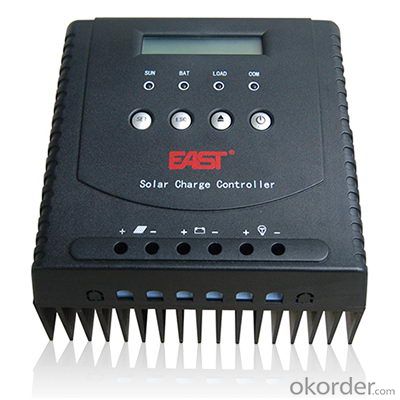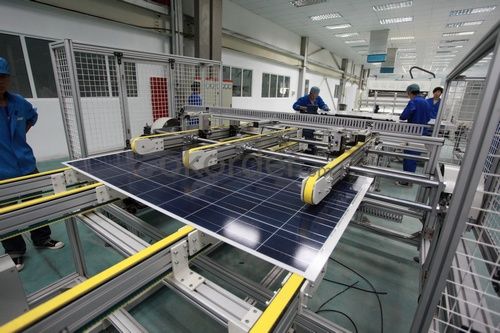Solar Charge Controller LCD 10A-60A Solar Charge Controller LCD 10A-60A
- Loading Port:
- China main port
- Payment Terms:
- TT or LC
- Min Order Qty:
- 1 pc
- Supply Capability:
- 1000 pc/month
OKorder Service Pledge
OKorder Financial Service
You Might Also Like
Solar Charge Controller LCD 10A-60A
This is a highly intelligent charge controller with (MPPT). The optimal and intelligent “MPPT + SOC” charge control is implemented. The power switching components consist of low-loss MOSFET type transistors that have a long operating life and guarantee high performance. The extremely low own consumption makes it especially suitable for solar home systems, solar street lamp system, advertising lighting, traffic management system, and other professional applications etc. With the reverse polarity protection, lightning protection, electronic fuse and automatic detection of faulty battery, the controller is robust, maintenance-free and user-friendly.
● Intelligent operation: the system will automatically start PV charging function without the manual operation.
● High efficiency MPPT function (optional): the system adopt maximum power point tracking technology, even if the battery using in the different condition, this MPPT controller could ensure the Maximum output power from the PV panels, and increase 20-30% electrical power using efficiency from solar panel.
● Reliability: Adopt the Hybrid controller to realize “MPPT+SOC” double intelligent charge control, ensure the product stability and reliability.
● Intelligent charge control: With automatic battery temperature compensation, constant current and constant voltage integrated charge mode, improve the battery's charging efficiency and working life.
● Battery protection: automatically detect the battery working condition, when overdischarge, the system will be shut down automatically, avoid wasting the battery energy.
● High efficiency: Power loop adopts low-loss MOSFET type transistors in series, PWM Soft switching technology is applied to reduce switching loss, Synchronous rectification technology is applied to decrease voltage drop, increase the system's efficiency.
● Intelligent: Illumination recognition auto power on(optional): the system can be set to auto turn on the load when lack of sun, such as fog,storm,night. Auto turn on the load, it is a good assistant of transportation illumination.
● Protection: Overcharge protection/ Over-discharge protection / Battery Reverse Current Protection / Overloading Protection/ Short
● Circuit Protection/ Reverse Polarity Connection Protection/ TVS lightning protection etc.
● LCD Display: to show the working mode of solar battery, seal-lead acid battery and load.
● Well Adaptability (optional): through the man-machine interface, charging current fine adjustment can be settable, suitable for Li-ion Battery, lead-acid battery and other storage system.
● Intelligent communication (optional): RS232 and dry connect
● Temperature compensation (optional): with external battery working temperature detective port, to adjust the charging voltage in time according to the battery working temperature
Model | F2448-10/M | F1224-20/M F2448-20/M | F1224-30/M F2448-30/M | F1224-40/M F2448-40/M | F1224-50/M F2448-50/M | F1224-60/M F2448-60/M |
System Voltage | 12V / 24V ;24V/ 48V | |||||
Rated Charging Current | 10A | 20A | 30A | 40A | 50A | 60A |
Rated Load Current | 10A | 20A | 30A | 40A | 50A | 60A |
PV Panels Configuration (Suggestion)(Imp≤Rated Current) | ≤10A | ≤20A | ≤30A | ≤40A | ≤50A | ≤60A |
Battery Capacity | 38Ah~800Ah | |||||
Max. Efficiency | > 98% | |||||
Static Dissipative | < 0.5%(system rated current) | |||||
Solar Battery Port Input Voltage | 12V:0-24V;24V:0-48V;48V:0-95V | |||||
Rated Battery Voltage | 12V / 24V ; 24V / 48V | |||||
Buck Charge Voltage | 14.6V / 29.2V±1% ; 29.2V/58.4V±1% | |||||
Float Charge Voltage | 14.4V / 28.8V±1% ; 28.8V/57.6V±1% | |||||
Overcharge Protection | 14.7V / 29.4V ±1% ; 29.4V / 58.8V±1% | |||||
Charging Resume Voltage | 13.2V /26.4V±1% ; 26.4V / 52.8V±1% | |||||
Undervoltage Alarm | 11.2V /22.4V±1% ; 22.4V / 44.8V±1% | |||||
Overdischarge Protection | 10.8 V / 21.6 ±0.3V ; 21.6V / 43.2 ±0.4V | |||||
Overdischarge Resume Start Voltage | 13.2 V / 26.4 ±0.3V ; 26.4 V / 52.8 ±0.4V | |||||
discharge Circuit Voltage Drop | < 5 %(System rated voltage) | |||||
Overload, Short-Circuit Protection | 125%(60S) / 150%(10S)/ short-circuit auto shut down; | |||||
PV Reverse Polarity Connection Protection | YES | |||||
Display | LCD + LED | |||||
Alarm Mode | sound(optional)/light alarm | |||||
Control Mode | Switch control / PWM | |||||
Working Temperature | c-20℃ ~ +45℃ | |||||
Relative Humidity | 0-95%(noncondensing) | |||||
Storage Temperature | -25℃ ~ +85℃ | |||||
Altitude | 1000m with rated power (increase 100m, reduce power 1%) Max.4000m | |||||
Storage Humidity | ≤85% | |||||
Installation Method | hanging vertical installation | |||||
Packing Dimension WxDxH(mm) | 164×168×55 | 164*168*100 | ||||
Weight(kg) | 0.85 | 2.05 | ||||
Packing Weight(kg) | 1.05 | 2.25 | ||||
Package | 8pcs/carton | |||||
· Q. What is an UPS and What it is for ?
An uninterruptible power supply (UPS) is a device that allows your computer or telephone switch or critical equipement to keep running for at least a short time or longer time when the primary power source is lost. It also provides protection from power surges, spikes, brownouts, interference and other unwanted problems on the supported equipment.
· Q. How long the UPS to run when power goes?
This can take 3 paths.
1.You can pick a UPS that is rated for pretty much the full VA you need so it will be running at 100% of capability and will thus last 'n' minutes.
2.You can pick a UPS that is rated at a much higher VA value than you really need so, for example, is running at 50% of capability and will thus last for longer than the UPS from option 1.
3.You can use extra external battery packs to run for longer. If charging capability allows, the more and the bigger batteries you take with, the longer time UPS runs.
or using a generator after about 6 hours, it will be more cost-effective, with a short runtime UPS to bridge the generator start-up gap.




- Q:What is the role of a bypass switch in a solar inverter?
- The role of a bypass switch in a solar inverter is to provide a means for redirecting the flow of electricity in case of an emergency or failure within the inverter. It allows for the direct connection of the solar panels to the utility grid, bypassing the inverter, ensuring a continuous supply of electricity even when the inverter is not functioning properly. This helps maintain the stability and reliability of the solar power system.
- Q:Does a solar inverter require any additional cooling or ventilation?
- Yes, a solar inverter typically requires additional cooling or ventilation to operate efficiently and prevent overheating. The heat generated during the conversion of DC to AC power needs to be dissipated to maintain optimal performance and prolong the lifespan of the inverter.
- Q:Can a solar inverter be used with solar-powered signage systems?
- Yes, a solar inverter can be used with solar-powered signage systems. Solar inverters are essential for converting the direct current (DC) generated by solar panels into alternating current (AC) that can be used to power electrical devices, including signage systems. The inverter ensures efficient utilization of solar energy and allows for seamless integration of solar power into signage systems.
- Q:Can a solar inverter be used with dual-axis solar trackers?
- Yes, a solar inverter can be used with dual-axis solar trackers. A solar inverter is responsible for converting the direct current (DC) generated by the solar panels into alternating current (AC) that can be used to power electrical devices or be fed into the grid. The dual-axis solar trackers enable the solar panels to follow the sun's movement in both horizontal and vertical directions, maximizing their exposure to sunlight throughout the day. The solar inverter can still perform its function of converting DC to AC regardless of the type of solar tracking system used.
- Q:How does a solar inverter handle voltage fluctuations from the grid?
- A solar inverter handles voltage fluctuations from the grid by constantly monitoring the voltage and adjusting its output accordingly. When the grid voltage increases or decreases, the inverter's control system regulates its own output voltage to match the changes, ensuring a stable and consistent supply of electricity is fed into the grid. This helps to maintain grid stability and protect the connected devices from potential damage caused by voltage fluctuations.
- Q:Can a solar inverter be used with bifacial solar panels?
- Yes, a solar inverter can be used with bifacial solar panels. Bifacial solar panels can generate electricity from both sides, capturing sunlight from both the front and back surfaces. The solar inverter is responsible for converting the DC power generated by the solar panels into AC power that can be used in homes or fed into the grid. Therefore, a solar inverter is an essential component for any solar panel system, including those with bifacial panels.
- Q:Can a solar inverter be used with a solar-powered electric gate system?
- Yes, a solar inverter can be used with a solar-powered electric gate system. The solar inverter is responsible for converting the DC power generated by the solar panels into AC power, which is required to operate the electric gate system. This allows the solar energy to be utilized efficiently in powering the gate system.
- Q:Can a solar inverter be used with a solar-powered disaster relief system?
- Yes, a solar inverter can be used with a solar-powered disaster relief system. A solar inverter is an essential component that converts the direct current (DC) generated by the solar panels into alternating current (AC), which is the form of electricity used in most appliances and the electrical grid. By using a solar inverter, the solar-powered disaster relief system can efficiently convert and utilize solar energy to power various devices and equipment needed in disaster relief efforts.
- Q:Can a solar inverter be used in a commercial solar system?
- Yes, a solar inverter can definitely be used in a commercial solar system. In fact, solar inverters are an essential component in converting the direct current (DC) electricity generated by solar panels into alternating current (AC) electricity that is compatible with the electrical grid and can be used by commercial buildings and businesses.
- Q:What is the power factor correction capability of a solar inverter?
- The power factor correction capability of a solar inverter refers to its ability to adjust the power factor of the electricity it produces. A power factor is a ratio that measures the efficiency of electrical power usage, with a value between 0 and 1. A solar inverter with good power factor correction capability can optimize the power factor towards unity (1), which indicates maximum efficiency. This helps in minimizing reactive power and reducing energy wastage, resulting in a more efficient and effective utilization of solar power.
1. Manufacturer Overview |
|
|---|---|
| Location | |
| Year Established | |
| Annual Output Value | |
| Main Markets | |
| Company Certifications | |
2. Manufacturer Certificates |
|
|---|---|
| a) Certification Name | |
| Range | |
| Reference | |
| Validity Period | |
3. Manufacturer Capability |
|
|---|---|
| a)Trade Capacity | |
| Nearest Port | |
| Export Percentage | |
| No.of Employees in Trade Department | |
| Language Spoken: | |
| b)Factory Information | |
| Factory Size: | |
| No. of Production Lines | |
| Contract Manufacturing | |
| Product Price Range | |
Send your message to us
Solar Charge Controller LCD 10A-60A Solar Charge Controller LCD 10A-60A
- Loading Port:
- China main port
- Payment Terms:
- TT or LC
- Min Order Qty:
- 1 pc
- Supply Capability:
- 1000 pc/month
OKorder Service Pledge
OKorder Financial Service
Similar products
New products
Hot products
Hot Searches
Related keywords
































